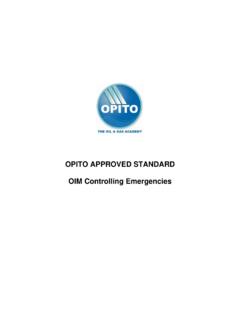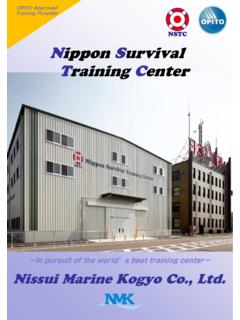Transcription of OFFSHORE TECHNOLOGY REPORT 2001/091
1 HSEH ealth & SafetyExecutiveInspecting and auditing themanagement of emergency responsePrepared byLINK Associates International Ltdfor the Health and Safety ExecutiveOFFSHORE TECHNOLOGY REPORT2001/091 HSEH ealth & SafetyExecutiveInspecting and auditing themanagement of emergency responseLINK Associates International LtdAspen DriveDerbyDE21 7 SGUnited KingdomHSE BOOKSii Crown copyright 2002 Applications for reproduction should be made in writing to:Copyright Unit, Her Majesty s Stationery Office,St Clements House, 2-16 Colegate, Norwich NR3 1 BQFirst published 2002 ISBN 0 7176 2321 1 All rights reserved. No part of this publication may bereproduced, stored in a retrieval system, or transmittedin any form or by any means (electronic, mechanical,photocopying, recording or otherwise) without the priorwritten permission of the copyright REPORT is made available by the Health and SafetyExecutive as part of a series of reports of work which hasbeen supported by funds provided by the the Executive, nor the contractors concernedassume any liability for the reports nor do theynecessarily reflect the views or policy of the Executive.
2 IiiSUMMARY Link Associates International Ltd had prepared this REPORT under contract to the OFFSHORE Safety Division of the Health and Safety Executive. Its primary intended purpose is as a source of information for use by HSE specialist inspection teams when drawing up inspection and audit initiatives in the field of emergency response management. The REPORT gives background information on the importance of OFFSHORE emergency response, on the content of emergency response systems, on the mechanisms established in Great Britain for assessing the emergency command capabilities of OFFSHORE managers, and it contains suggestions for the Regulator regarding inspection and auditing.
3 For the purpose of this REPORT an emergency response system is considered to comprise of two parts; emergency command and the remainder of the emergency response system. The REPORT examines the health and safety legal duties applying to these two areas and provides suggestions to the Health and Safety Executive on how it might be involved in influencing and regulating emergency response standards . The REPORT contains detailed information on the OFFSHORE Petroleum Industry Training Organisation ( opito ) Standard for emergency command, and on how the Standard is applied by opito approved bodies. It is suggested that this information should be used as a knowledge base to inform and stimulate discussion rather than in direct regulatory interventions.
4 The REPORT concludes that: emergency response, which forms part of the emergency preparedness of an installation, remains important to OFFSHORE health and safety and that it is appropriate for interest in this subject to be continually revitalised; emergency response systems must reflect the ability of an installation to withstand an emergency, the risks from which are required to be demonstrated ALARP under the safety case assessment and acceptance procedures and, in particular, must reflect the performance standards of the accepted safety case for mustering and the endurance times of egress routes and temporary refuges, and for evacuation and escape. emergency command capabilities of the OFFSHORE management team is at the centre of the emergency response system, and can only be developed and assessed using scenario based training and assessment techniques conducted by expert organisations; the opito Standard on emergency command sets the agreed approach to the training and approved assessment of emergency command for the OFFSHORE industry and that the Regulator should continue to work with opito on reviewing the Standard and accreditation procedures.
5 The remainder of the emergency response system can be regulated following the relevant statutory requirements, most of which appear in the OFFSHORE Installations Prevention of Fire end Explosion and Emergency Response Regulations, the Pipelines Safety Regulations and the OFFSHORE Installations Safety Case Regulations. Ideas on how this might be done are included in the REPORT . iv vCONTENTS Summary page iii Contents page v 1. Purpose of REPORT page 1 2.
6 Background to Emergency Response Systems page 2 Purpose of OFFSHORE Emergency Response Systems page 2 Legal Requirements page 2 The Piper Alpha Disaster page 3 3. Emergency Preparedness page 5 Overview page 5 Characteristics of an Installation page 5 Management of Emergency Response System page 6 4. General Principles of Inspection and Audit page 9 5. Inspection and Audit of Emergency Command Capabilities page 10 Questions for the Regulator page 10 6.
7 Inspection and Audit of the Remainder of the Emergency Response System page13 Emergency Response Plan page 13 Detection of Incidents page 19 Communication and Alarms page 19 Mustering page 20 Drills and Exercises page 21 Information to Personnel-The Station Bill page 21 Facilities Check List page 22 7.
8 Inspection and Audit of Emergency Response Hardware page 23 General page 23 Helideck Emergencies page 24 Additional Background Information page 24 8. Conclusions page 25 Appendix 1 opito Emergency Response standards page 26 opito page 26 Emergency Control Standard page 26 Standard for those having Specialist Responsibilities page 27 Standard for those having no Specialist Responsibilities page 28 Appendix 2 Arrangements in the OFFSHORE Industry for Assessing Emergency Command Capabilities page 29 Importance of Command Capabilities
9 Page 29 Coaching and Assessing Emergency Command Capabilities page 29 Appendix 3 Implementation of the opito Standard page 31 Principles of Scenario Based Assessments page 31 Selecting Scenarios page 31 Component Analysis page 36 Annex A Generic Check List for the Assessment of Command Capabilities page 38 Annex B Components of Emergency Response Systems page 46 Annex C Overarching Emergency Response Prompt Sheet page 48 Annex D Typical Emergency Procedures Prompt Sheet page 49 Annex E Drills and Exercises Prompt Sheet page 50 Annex F Station Bill Prompt Sheet page 51 viAnnex G - Generic Check List for the Inspection and Audit of Emergency Response Hardware and Software page 52 Annex H Typical Emergency Response Facilities for Platform Evacuation page 57 Annex I Facility Considerations During Emergencies page 58 Bibliography
10 Page 61 Glossary page 63 11. PURPOSE OF REPORT This REPORT provides background information and practical help to the Regulator on the inspection and audit of emergency response arrangements for OFFSHORE installations. Although a matter for the Regulator, it is intended that the REPORT or parts of the REPORT should be used mainly by specialist groups within the OFFSHORE Division of HSE to devise guidance to inspectors for use in general inspection and in targeted initiatives directed at emergency response management. Emergency response forms that part of the emergency preparedness of an OFFSHORE installation that comes into play once an emergency has occurred and contributes to reducing risks to ALARP.



















